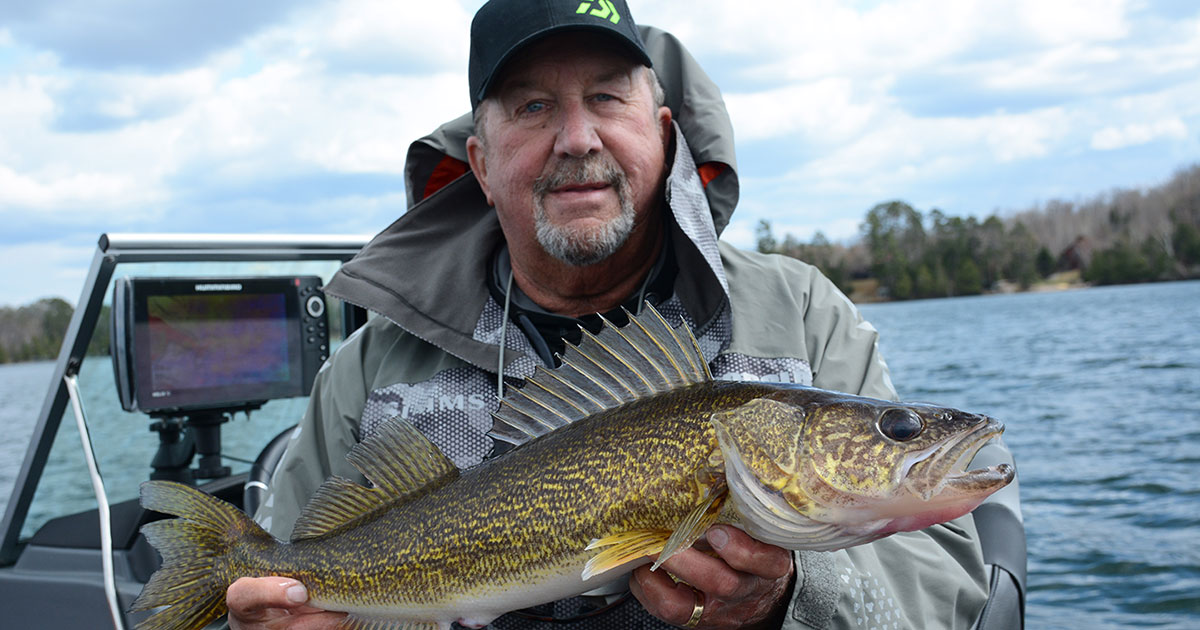Ego Fishing Report

It’s that time of year again. Kids are back at school, football’s started, and fish will soon be putting on the feed for the long, cold months ahead. And while the pull for the avid outdoorsman or woman can be to ready for birds, bucks, field, and forest, serious walleye anglers know it’s also time to be on the water.
Fish are starting to make moves; the best walleye fishing takes place when waters hit the upper to mid-50s. This is when they begin aggressively targeting baitfish like shad, perch, and fall-spawning tullibees (cisco), often roaming shallow from dusk and throughout the night putting on the feed.
Location, Location, Location
Fall days can be epic, as long as you’re in the right place. Expect autumn walleyes to hold near main lake points, drop-offs, and structures like rock piles and gravel bars near deeper water where they can ambush prey and rest to metabolize food.
Moving water is also a fall magnet, with walleyes chasing migrating baitfish into adjoining creeks and rivers on lakes.
But, as mentioned, come nighttime, anticipate walleyes moving into as little as 2-8 feet of water near shorelines, especially windswept shores. On rivers, you will find the same phenomena, with walleyes intercepting food along shallow rock, creek inlets, river bends, wingdams, and riprap.
Troll Right Now
Although it’s fallen by the wayside with FF sonar, trolling is still an incredibly effective way to catch walleyes, especially now with water temps sliding into the 60s and down into the upper 50s. You can still use your electronics, but rather than sniping individual fish, look for schools of baitfish cruising the open basins and either longline or use leadcore to pull crankbaits or spinners, the latter with a minnow instead of a ‘crawler, something a lot of anglers don’t do anymore.
Jigging Just Produces
Again, during the day, use your electronics to find vertical structure, deep breaks, and vertically jig those areas. ¼- to 3/8-ounce jigs tipped with lively minnows are hard to pass up. On river systems, find current seams, pools, or eddies, and concentrate on boat control, keeping your line as vertical as possible or in position to pitch to promising areas.
Veteran Minnesota Fishing Guide, Tom Neustrom, is a master at jigging and loves what fall brings to his boat each year.
“When water temperatures drop from 70 to 75 degrees, that gets the walleyes moving. I move back to jig fishing because you’re keying in on pods of fish again, and I think that’s the important thing to know about the transitional period—when the temperature starts to drop the fish start to feed, so you really need to monitor the water temperature.”
Neustrom is a fan of jigging in fall because he can cover water quickly and key in on active fish.
“In terms of depths, I ascribe to the spring forward, fall back saying, meaning move shallow during the day in the spring and move deeper during the day in the fall. We’re not in the six, eight, or ten feet we’d be jigging in the spring. I’m looking for fish in 25 to 35 feet of water in the fall during the day – as well as the edges of deep water to shallower water, say 12 to 20 feet of water,” noted Neustrom.
“In the fall, it’s crucial to pay attention to depth breaks. When you’re looking at your LakeMaster map or whatever map you’re using, you want to key on major points that dip into deep water and start fishing right on the edge. I’m a really big fan of jigging points in the fall.”
Pitching Programs
Rapala Jigging Raps and Rippin’ Raps, Northland Pitchin’ Puppet, and bladebaits are also fall favorites, with bladebaits really shining on rivers where the water may be turbid and you need the vibration to attract fish. And on lakes and rivers, chunky paddletail and jighead combos are also consistent producers, but you’ll have to experiment with the retrieve. Sometimes, walleyes want them ripped—other times fished on a moderate, straight retrieve. For the latter, underspin jigheads are recommended for extra flash and attraction.
Cast Cranks
Casting crankbaits like DAIWA’s SC Shads, Rapala Shad Raps, and Berkley Flickr Shads provide another avenue to explore, working shallow flats and still-green weededges. And stickbaits like the DAIWA HMKL Minnow and Rapala Husky Jerks, well, they’re a staple for flinging in shallow water at night, which we’ll discuss below.
Live Bait Rigging
One of the deadliest ways for catching walleyes in fall on lakes? Rigging fat, lively creek chubs or redtails on a slip sinker rig. Drag slowly over breaklines or points.
Post-turnover—when dissolved oxygen is more evenly dispersed throughout all depths—walleyes can be literally anywhere. Most anglers still target steep breaks, sunken islands, points, etc., but Minnesota guide, Brian “Bro” Brosdahl is fond of fishing shallower.
“A majority of my fall live bait rigging is done in 10’ and less,” said Bro. “Especially around rock, from softball- to Volkswagen-sized boulders to jagged shield rock. On rivers, you’re talking submerged riprap, wingdams, and other soft-to-hard bottom transitions.”
Just remember to set the hook after a brief countdown and with a slow sweep.
Bro encourages anglers to use the first couple bites to determine the best hook-setting procedure. “If you get a bite and pull on it and the fish is already hooked, you know they’re eating it. Don’t overfeed the fish. There’s no reason to pull their butthole out the mouth. Most of the time, I’m feeding them for around 5 seconds. The only exception is if I’m using giant chubs—then I’ll give ‘em a bit longer.”
Bro continued: “When I feel a hit I’ll feed line, then I’ll check before I set the hook, pulling the chub a little bit – maybe a couple short pulls so the walleye eats it a bit more. I call this the ‘tease.’ Teasing walleyes a little bit really gets them to commit. Big walleyes are like ‘give me my steak back!’ Even in tournament situations when I watch guys feed fish for minutes, all it takes is a little tease.”
The exception is rigging during extreme high-pressure situations when the tease can turn some walleyes off.
“If they don’t eat after the tease, they’re typically small fish. But bug the big fish and they’ll gobble almost every time, even during post-frontal conditions.”
Night Fishing
In fall, with walleyes moving shallow after dark, casting stickbaits or swimbaits over sand, gravel, or sparsely weeded flats can be dynamite – again, especially areas where the wind has been blowing into for a sustained period or near creek mouths and points.
The nice thing about walleye night fishing in fall is you don’t really need a boat, just a couple of spinning rods, a small box of stickbaits, pliers, your waders, headlamp, and a good net, like an EGO Large Wade model that will clip easily to a lanyard or over your shoulder. While all the methods above will work for fall walleyes, this is our favorite!





